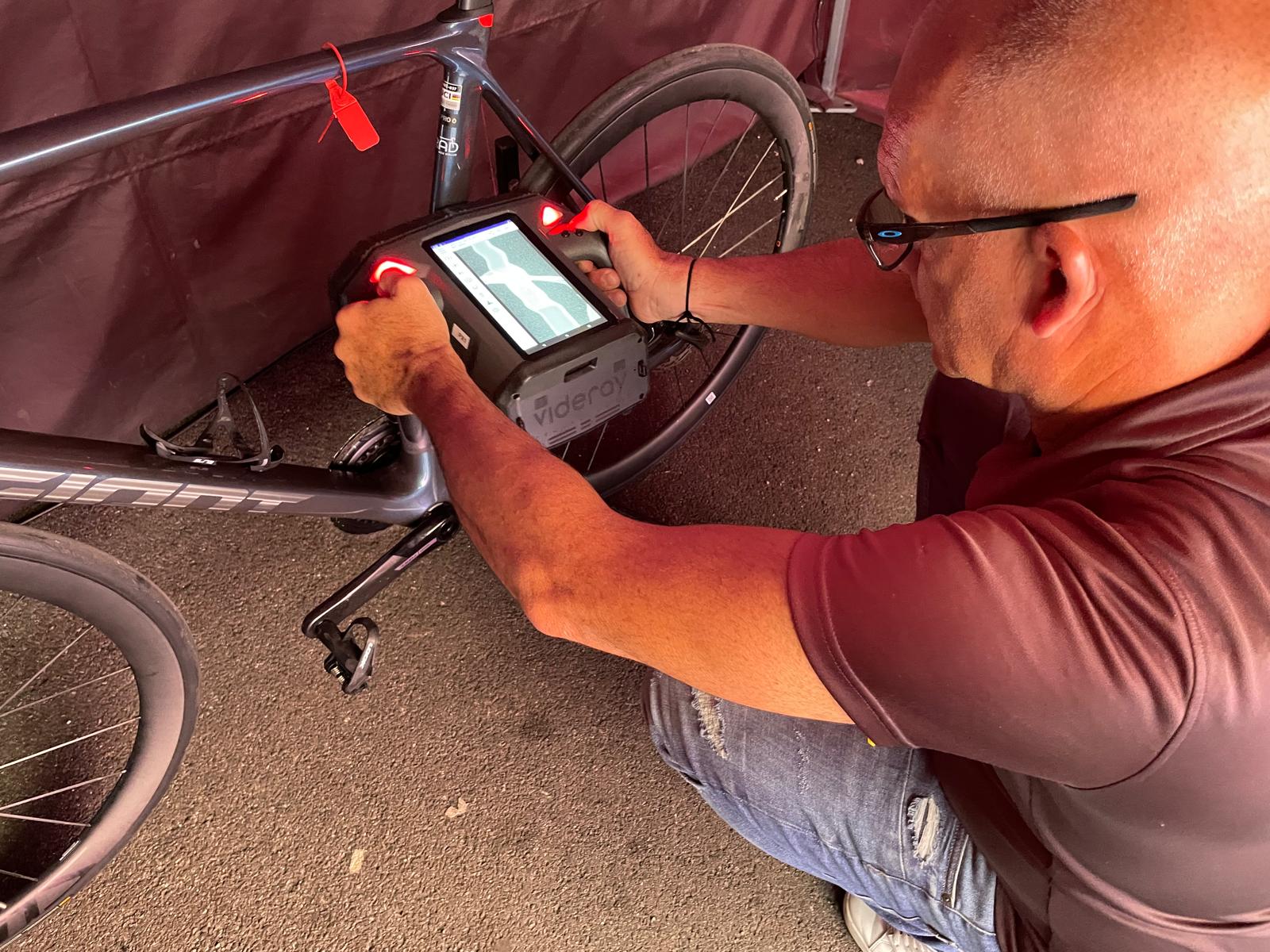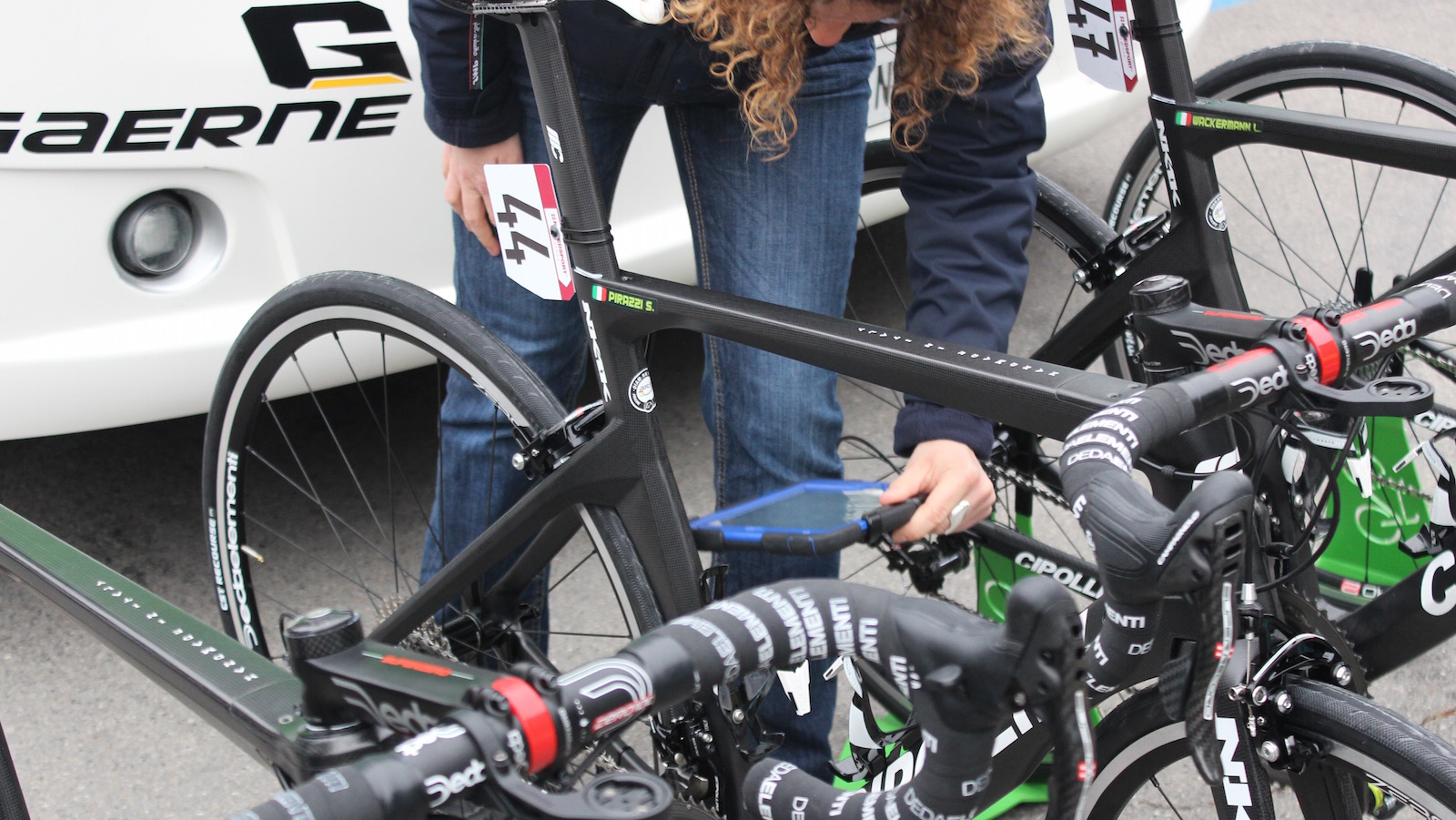The UCI has revealed particulars of their newest methods and technique to detect and deter mechanical doping in biking, with bikes now checked utilizing a handheld backscatter x-ray gadget that may see what’s hidden inside frames, wheels and any a part of a motorcycle.
Cyclingnews and a choose group of different media had been allowed into the protected anti-doping and technological fraud compound on the end of stage 18 of the Giro d’Italia in Cesano Moderno to see how the UCI perform their checks.
The UCI appointed former US Homeland Safety Investigator Nick Raudenski a 12 months in the past to steer the technique for the combat towards technological fraud. It was seen as a daring appointment by UCI president Davd Lappartient and maybe an indication of the necessity to guarantee hidden motors should not used to falsify outcomes. Lappartient has admitted {that a} high-profile mechanical doping case would “destroy the game.”
Raudenski is utilizing his expertise investigating match-fixing and corruption for FIFA and UEFA, and newer work as Head of Intelligence & Investigations on the anti-doping Worldwide Testing Company, to mix bike checks with intelligence and whistleblowing.
“We’re in a technological arms race,” Raudenski admitted to Cyclingnews in an interview after the backscatter x-ray gadget presentation.
“Parts are getting lighter and smaller and so simpler to hide and tougher to detect. We’re up towards the problem of attempting to remain out in entrance or not less than not up to now behind within the cat and mouse sport of what’s the new means that individuals may probably attempt to cheat.”
It’s not solely gear. Raudenski, like many individuals, is commonly suspicious of riders’ performances in sure races. It sparks the pure investigator in him.
The newest race content material, interviews, options, evaluations and professional shopping for guides, direct to your inbox!
“It is about wanting on the total image, watching how performances occur, watching biomechanical behaviour, watching how riders are appearing and the way they react to us once we do a motorcycle test,” he defined.
“Most are literally blissful and thank us as a result of they wish to ensure they are not using towards anyone that’s attempting to cheat.”
Cyclocross rider Femke Van den Driessche stays the one athlete ever to be caught and sanctioned for motor doping again in 2016.
British journalist Chris Marshall Bell has investigated mechanical doping a size for his Ghost within the Machine podcast and likewise written about motor doping for Cyclingnews on the topic. There are suspicions that hidden motors and even magnetic gadgets in wheels could have been utilized in main skilled races, way back to 1999, however no instances have ever been irrefutably confirmed or a disciplinary course of opened.
“I and my staff problem ourselves to ask the place we’re at now and why we aren’t discovering something,” Raudenski mentioned.
“We query if our instruments are updated, is the method proper, is there new expertise on the market or new elements that we’re not seeing. It is a continued evolution to make our take a look at and expertise higher. To verify we’re not lacking one thing.”
Contained in the UCI technological fraud tent

The UCI has bike inspector technicians and the backscatter x-ray gadget at various main biking and mountain bike races, to test bikes and create a robust sense of deterrence.
The UCI has three of the gadgets, which value €45,000 every, with a substantial funds allotted to what the UCI prefers to name ‘technological fraud’ moderately than mechanical doping.
Based mostly on particular info and intelligence, suspicions or only a randomly chosen course of, riders are stopped past the end line, a particular purple UCI tag is connected to their body, after which taken to the anti-doping space for inspection. Riders who’re chosen for anti-doping testing often face a motorcycle test alongside random and focused checks.
The UCI nonetheless makes use of the pill gadget to test bikes at race begins, regardless of doubts about its means to detect magnetic exercise. They now mix that with between seven and 15 backscatter x-ray checks per day.
Within the black UCI tent within the protected Giro d’Italia anti-doping compound, Cyclingnews noticed how the UCI technicians weigh the bikes to detect any further hidden gear after which slowly scan the bike with the backscatter x-ray gadget.
The display captures an X-ray picture and clearly exhibits’ contained in the body and wheels. The technicians are skilled and skilled in differentiating between the batteries and wires of digital gear techniques and any hidden gadgets.
“We will see all the things and each facet, and we are able to take a look at particular areas and zoom in on particulars to focus on sure issues,” Raudenski mentioned, insisting the method and expertise are sturdy.

Riders and staff employees are allowed to look at the method after which signal an official doc saying the bike was checked on a particular day and time. The UCI retains data of bikes examined and cross-checks that with bikes and frames registered with the UCI.
When David Lappartient was elected as UCI president in 2017, he mentioned he did not need technological fraud to proceed as ‘a sizzling subject’ and he personally offered a cell X-ray cupboard in 2018.
The usage of the backscatter x-ray gadget is the newest step within the ‘technological arms race.’
Cyclingnews has seen Raudenski at main race finishes as he supervises the bike test course of. He retains a low profile, however most groups already know who’s and the important work he does.
At latest Giro d’Italia stage finishes, Cyclingnews noticed Raudenski level a handheld gadget, maybe a warmth gun of some type, at riders’ bikes slowing past the end line. Nevertheless, he refused to touch upon the gadget or different applied sciences he and the UCI could use sooner or later.
The UCI are additionally apparently contemplating the usage of energy and cadence information, mixed with AI, to supply a rider’s “energy passport” just like the Athlete Organic Passport that’s used to combat blood doping after the EPO period.
Raudenski admits that the UCI’s work is generally about appearing as a deterrent. Nevertheless, he isn’t afraid to research earlier suspicious performances and gear. They are going to be laborious to show however may assist sooner or later to know mechanical doping.
“Folks perceive that if I cross the end line with a motor on my bike, there is a excessive likelihood that there is going to be a test. So there’s a deterrent impact,” Raudenski mentioned.
“We’re ensuring that we now have sturdy processes, that our authorized frameworks and the laws are updated, that the gear laws are updated, and that we’re staying forward of what can and what cannot be used.”
Final September, the UCI launched a particular mechanical doping whistleblower rewards programme, saying that info to assist goal testing and investigations can be “facilitated by monetary motivation, help, and/or reward for info”.
Raudenski sees and research all of the rumours about hidden motors however focuses on the info.
“Do I get up sweating in the midst of the evening, fearing that I am lacking one thing? Not in the meanwhile,” he advised Cyclingnews.
“You must separate reality from fiction, proof from rumours. That is the place I spend the vast majority of my time.
“It is not about what I believe. It is about what I can show. I am pushed by proof, by issues that I really feel we take tangible actions on.
“In fact, we’re not blind, we’re not deaf to rumours and allegations which have occurred prior to now. I am not shying away from something that I really feel goes to proceed to advertise the credibility of biking.”